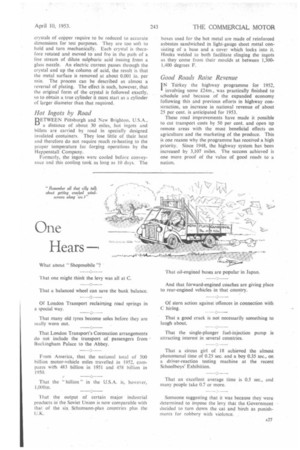Passing Comments
Page 28

Page 29

If you've noticed an error in this article please click here to report it so we can fix it.
Up on Their Toes!
IN the days when the writer of these words had bare I and, probably, grubby knees " fare-dodging " was a game that was popular with our contemporaries if not with our parents. Apart from having the advantage that anyone could join in, the prizes—if not quite on the professional scale—were at least advantageous, for a couple of successes would purchase a large and fruity bun. But, as we recall it, the sport was the thing. When unavoidable, we paid up cheerfully and, at times when the tram was full, we stood up gracefully without need for the then frequent ultimatum of "half-fares stand." When we reached the age of greater discretion and started to earn several good shillings a week, we paid our full fare conscientiously and with some measure of
pride. , In these later years a more benevolent hand, bearing a variety of concessionary fares, has been extended towards youth in general. To judge by reports, however, senior teen-agers are suspected of exercising on a grind scale concessions which are no longer theirs by right of age. In short, and as was rather suspected, youth is not what it was.
A simple solution to the operator's difficulties in this connection seems to lie in that old demand: "Half-fares stand." The thought that the economies in question might thus be publicly pilloried would probably go a long way in emphasizing the fact that A.26 the almost-innocent fun of the inky-fingered is not to be overlooked when practised by those of the hair-cream and lipstick age. The danger of being blamed for his passengers' delinquencies would also be minimized for the conductor, who is known to be entitled to act the sergeant-major when occasion so demands.
Electrolytic "Machining"
IVIANY interesting processes and methods of testing ivIwere shown to visitors at an at home held on March 23 by the British Non-Ferrous Metals Research Association. This body can provide such knowledge as exists on any particular application of a metal and affords the means for carrying out research where sufficient is not available. Both needs can, in general, be met more economically than they could be by an individual concern. The membership at home and in the Commonwealth is nearly 600 and the laboratory in Euston Street, London, N.W.1, has a floor area of 45,000 sq. ft.
Most of the members are producers of non-ferrous metals but a substantial number is comprised of engineering companies. Problems dealt with concern such matters as corrosion resistance, difficulties with electric plating, faults found in metal working, control effects of grain size and porosity in castings.
One apparatus which attracted much interest was an electrolytic "lathe." For certain test work, single crystals of copper require to be reduced to accurate dimensions for test purposes. They are too soft to hold and turn mechanically. Each crystal is therefore rotated and moved to and fro in the path of a One stream of dilute sulphuric acid issuing from a glass nozzle. An electric current passes through the crystal and up the column of acid, the result is that the metal surface is removed at about 0.001 in. per min. The process can be described as almost a reversal of plating. The effect is such, however, that the original form of the crystal is followed exactly, so to obtain a true cylinder it must start as a cylinder of larger diameter than that required.
Hot Ingots by Road
BETWEEN Pittsburgh and New Brighton. U.S.A., a distance of about 30 miles, hot ingots and billets are carried by road in specially designed insulated containers. They lose little of their heat and therefore do not require much re-heating to the proper temperature for forging operations by the Heppenstall Company.
Formerly, the ingots were cooled before conveyance and this cooling took as long as 10 days. The boxes used for the hot metal are made of reinforced asbestos sandwiched in light-gauge sheet metal consisting of a base and a cover which locks into it. Flooks welded to both facilitate slinging the ingots as they come from their moulds at between 1,3001,400 degrees F.
Good Roads Raise Revenue
1N Turkey the highway programme for 1952, involving some f24m., was practically finished to schedule and because of the expanded economy following this and previous efforts in highway construction, an increase in national revenue of about 25 per cent. is anticipated for 1953.
These road improvements have made it possible to cut transport costs by 50 per cent, and open up remote areas with the most beneficial effects on agriculture and the marketing of the produce. This is one reason why the programme has received a high priority. Since 1948, the highway system has been increased by 3,107 miles. The success achieved is one more proof of the value of good roads to a nation.




















































































